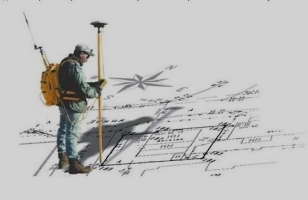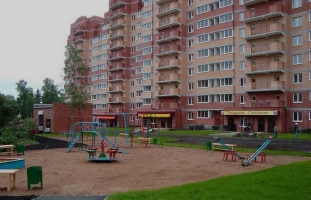How to carry out land surveying of an apartment building. In simple words: land surveying of apartment buildings
Dear readers!
Here is an article about land surveying, where we tried to ask all the frequently asked questions and wrote answers to them.
We propose to start our discussion with the basics, that is, with the very concept of land surveying of the local area. Of course, there are many owners of plots who already believe that this very plot near the house originally belonged to them, but this is not entirely true.
The right to own the local area comes only after official entry into the Unified State Register and receipt of a cadastral number.
Let's take a closer look at this.

As Article 36 of the Land Code states, the land under the house can belong to the residents - they have full legislative rights to do so. But there is some interference between this site and the owner of the house - this is legal illiteracy. Officials are aware of the lackluster picture of public ignorance and take advantage of this by declaring ownership of only the plot on which the house stands. The question remains, which can be characterized as follows: how to grow a tree where a house already stands? Of course not. You need to be able to draw up land surveying of the local area, that’s all. Sometimes complete absurdity happens, when the documents seem to be drawn up correctly, but instead of a lush garden, garages have been installed under the house, and not by the residents of the house, but by entrepreneurs. You need to be able to defend your property in this matter too!
The survey specialist will first of all pay close attention to your application. Firstly, you need to state that you are asking to form and register the plot as property, and not asking to allocate a plot - this is a mistake. Secondly, the wording “Plot for apartment building and the adjacent territory." If the official does not find this miracle line in the application, there is a chance that you will receive the land under the foundation of the house as a plot.
Not all difficulties in land surveying relate to bureaucracy - often the residents themselves create imaginary problems for themselves. Remember that you cannot decide anything intuitively in matters of legislation - you need to find out, ask, and be interested in everything. Thus, many believe that land surveying will not work without an HOA. However, once you look at the question a little more closely, it turns out that there is a way out and the impossible is possible!
There is also a separate cohort of fighters for justice, whose actions only aggravate worldly injustice. They claim that “private property is bad, everything should belong to the people!” However, they forget that besides law-abiding citizens, there are others who will happily use the liberated territory for their own purposes. So it's better to take local area at your disposal, and there it may be for people, even for development - it doesn’t matter, because the land will be yours.
Local area surveying experts will not only relieve you of prejudices about owning private property, but will also assure any resident apartment building is that he also has the right to own a plot of land near his home. Our specialists know exactly what questions you already have and how to solve them.
The main problem in the case of apartment buildings is the division of the adjacent area. You can’t just go out, put a fence around a meter by meter area and say, “The plot is mine, I live in this house.” All this must be legally formalized and only a specialist can help you in the matter of distribution of land around the house. Moreover, there are often children’s playgrounds near the house, adjacent to other premises, the residents of which also have the right to property. Land surveying experts can easily resolve these issues.
In fact, the skill of lawyers in land surveying the local area is many years of work, which has created a unique experience. Residents who are little familiar with land laws are unlikely to be able to quickly cope with the registration of a site near an apartment building, even if they unite. Ahead of the enthusiasts is still waiting for collecting applications from the owners, surveying, obtaining a number of documents and much more. Naturally, under the clear guidance of an expert, this process accelerates.
Below we provide answers to the most frequently asked questions from residents regarding land surveying near an apartment building:
1. Why is land surveying necessary at all?

In simple terms, land surveying is the division of land and the establishment of boundaries in individual areas. This action is necessary to create confidence among residents regarding the ownership of this site, because the Constitution itself states this Russian Federation: citizens and their associations have the right of private ownership of land.
Starting from March 1, 2005, a procedure for exercising this right to property appeared - this is the time the Housing Code of the Russian Federation came into force. And back in December, on the 29th of 2004, Federal Law No. 189-F3 was issued, which wrote about the creation of the above-mentioned Housing Code of the Russian Federation and that the formed land plot can become the property of residents free of charge.
Residents who purchased a plot of land have the right to decide for themselves what the fate of the received lands will be. Some completely forget about their possessions, leaving them to themselves, others take care of them: they install playgrounds, sports complexes, fences, sidewalks, and so on.
Resolving the issue of using the resulting plot is already a matter of residents’ solidarity. The main thing that land surveying helps solve is defining the boundaries of responsibility of management companies, because they are also responsible for the condition of lawns, trees, environmental conditions, and more.
2. What if the survey is not completed?

Only the residents of the apartment building will be left in the red. Here is a short list of the consequences of inaction in land surveying matters:
- Residents will not be able to demand from management companies basic cleaning of the territory, maintenance of yard landscaping and other privileges. In addition, there will simply be no responsible person;
- as a result of legislative amendments in 2010, an unregistered local area is the reason for the refusal of the entire house to participate in the capital repair program. It turns out that the residents will not receive either repairs, money, or the site itself;
- yes myself Town Planning Code The Russian Federation claims that such a house with confusion over the ownership of the territory is not amenable to major repairs, reconstruction and other large-scale work.
You should not lose sight of the obstinacy of the residents of neighboring houses - if the land surveying is not properly formalized, “friendly” neighbors will happily and legally be able to take away the adjacent territories from the residents. But if you try to defend your case in court without having documentary support, you will have to wait ten years, and then without any guarantee of victory!
3. Who can carry out land surveying?

If you look through the housing and land legislation of the Russian Federation, it turns out that land surveying can be carried out by local self-government bodies, as well as state authorities of a constituent entity of the Russian Federation.
There are 2 options for land surveying:
- according to the work schedule, municipal apartment buildings, or rather the adjacent territory, will be demarcated at the expense of the city budget;
- if self-government bodies are involved in this issue, money is also taken from the city budget.
But there is a case when the residents of apartment buildings themselves take on the formation of a local area. The decision to mark the territory is made during a formal meeting of residents, where citizens determine an authorized person. On his behalf, an appeal is made to a contracting organization that has a license to carry out land management work.
Residents can also address this issue to the Committee for the Management of Urban Lands and Municipal Property. To do this, you must have with you an application for the preparation of a plot diagram on the cadastral plan. If all the necessary information is included in this application, that is, there are plans, a list of technical equipment, information about objects within the site, etc., the Committee gets down to business. First, he prepares, then approves, and finally approves the layout of the land plot. After this, you can contact a contracting company to carry out cadastral work.
4. Differences in the land surveying procedure if the house is occupied by a management company or a homeowners’ association.

In general, there are no differences. It doesn't matter who manages the house, the company or the community of residents. It is important that each organization fulfills its powers within the framework of the agreement, and the issue of the land surveying procedure, anyway, will be resolved at the general meeting.
5. How much will land surveying cost?

First, you need to determine who should pay for it in the first place. Often, the owners themselves pay for the land surveying procedure, but there are also some cases when this is done by persons who have concluded the relevant agreement. Pricing policy largely depends on the company’s requests and ranges on average from 15 to 35 thousand rubles for the entire scope of work.
6. How long does it take to survey?

These nuances are decided by the clear terms of the contract. The customer and the contractor must establish this in advance. As experience shows, land surveying usually lasts 1.5-2 months, but it can take as long as 4.
7. What is the market value of land plots for an apartment building?

You can find out the true cost of a plot of land under an apartment building. This information is owned by the territorial bodies of the Federal Real Estate Cadastre Agency. You can find out the cost of land for free - the price base is provided for taxpayers. Upon request, you can obtain the number of the cadastral object, as well as its value. This can be done either by submitting a request in writing, or in a modern way - by going online to the website of the Federal Real Estate Cadastre Agency.
8. What is done in controversial issues regarding the division of a house plot?

Here everything is decided strictly according to the law. The division of the territory occurs in accordance with the current land and town planning legislation.
As stated in paragraph 4 of Article 43 of the Town Planning Code of the Russian Federation, the size of the adjacent plot is determined taking into account the actual use of the territory, as well as town planning norms and rules that were in force during the development of the land.
And as Article 7, Article 36 of the Land Code of the Russian Federation states, boundaries are determined based on the position of adjacent areas and the natural division of the territory. The size of the formed plot largely depends on the area occupied by all real estate properties owned by the owners applying for land surveying. Compliance with basic requirements plays a significant role fire safety, ecology and sanitation.
Land ownership should not interfere with the rights of other people. For example, it is unacceptable to divide a plot in favor of the owners if such division could cause harm to residents of neighboring houses, tenants and other people and structures.
It may happen that the actual size of the land plot is less than the theoretical one. Unfortunately, according to the decree of September 26, 1997 of the Government of the Russian Federation, this situation is not decided in favor of the residents - the boundaries are set according to the actual size of the land plot.
9. Is it possible to install a fence (fence) in a demarcated area under an apartment building?

This issue is being resolved in the Department of Urban Planning and Architecture of the City Administration. The representative of the owners of the premises of the house must contact them individually. The issue of satisfying the request will be taken for consideration and, if everything complies with urban planning standards, the application will be approved.
10. With whom should the boundaries of the formed land plot be agreed upon?
![]()
Since July 24, 2007, thanks to the Federal Law No. 221-FZ “On the State Real Estate Cadastre”, the location of boundaries is agreed upon only with the owners of adjacent territories by right:
- property (only if such plots owned by the state are not issued indefinitely (for life) as a heritage, or if it is not a municipal or state institution issued for lifelong use to a legal entity);
- lifelong inheritable ownership;
- perpetual use (only if the object is not a state or municipal institution);
- lease (the exception is lease up to 5 years - in such cases, tenants do not have to apply for permission).
11. When voting on the land surveying of an apartment building, what percentage of votes is decisive for making a decision?

The procedure for holding general meetings of owners, voting and other details are clearly described in Articles 45-48 of the Housing Code of the Russian Federation. Exactly half, that is, 50% of the residents, is enough to make a decision on land surveying of an apartment building.
12. Is the formed land plot property or is it still leased?

This has already been written above. Housing legislation states that the site under an apartment building is transferred to the ownership of the residents - they have the right to do so every right. But there are exceptions when the land is withdrawn from circulation and in other special cases. In such situations, the site is actually rented.
13. Can an individual resident dispose of a share of a land plot under an apartment building at his own discretion?

Even at the beginning, you need to dot all the i’s. Each resident actually has the right to use the territory at their own discretion. But before individualizing any part of the land, it is necessary to democratically get together and determine whether the plot will be divided into shares or will remain common property. If the decision is made without quarrels, insults and clearly by voting, then everyone will get what they want. Otherwise, the proceedings will go to court.
The Housing Code of the Russian Federation, or rather Article 36, states that the land plot is also included in the property of an apartment building, like the roof, bearing structures, equipment, etc. All this property can either be used jointly or be divided between each owner separately. The meeting of these owners will be decisive in this matter.
14. What to do with built-in and attached premises during land surveying? What role do legal entities (such as shops) play in subdividing a site?

Again, let’s return to Article 36 of the Housing Code of the Russian Federation, which states that absolutely all property of an apartment building (and this includes the land plot, landscaping and landscaping elements, as well as any other objects located on the territory) rightfully belongs to the owners of the apartments in the house.
If entity owns any premises in the disputed house, then the owner of the store, cafeteria, hairdresser or anything else is also the owner. As a result, the decision on the formation of a local area is made in agreement during a discussion with the participation of a legal entity. It does not matter whether the owner maintains residential or non-residential premises.
15. What to do with heating mains? Who is responsible for them, repairs them and maintains their welfare? Should the owner of heating mains and other communications pay the owners of the demarcated land for the use of it?

Service organizations that are their suppliers are responsible for communications. All the burdens of maintaining communications in normal condition fall on the shoulders of these companies, which are the owners of the property. This is legally confirmed in Article 210 of the Code of the Russian Federation. Even during the formation and determination of the demarcated territory, security zones with an area required for normal conditions implementation of operation of communication networks.
16. Who is obliged to pay for the repair of roads, improvement facilities such as playgrounds, sports complexes, fences, household plots, etc.?

This question is partially answered by Article 36 of the Housing Code of the Russian Federation, or rather its second paragraph. According to the provisions therein, property owners in an apartment building own, use and dispose of the property independently. All objects are common, that is, they are common property. And according to Article 210 of the Civil Code of the Russian Federation, common possessions (property) in an apartment building (this includes objects located on the land plot) are repaired and maintained at the expense of the owners. It turns out that playgrounds, sidewalks, fences, etc. must be maintained by the owners of premises in an apartment building.
17. What benefits are there for paying land tax for veterans, disabled people, etc. (in general, for beneficiaries)?

It’s worth noting right away that no one will be able to completely avoid paying taxes. to an individual- This procedure is now mandatory.
Provided that the land plot under the apartment building is formed and entered into the cadastral register, the procedure for periodic payment of taxes begins. All owners of premises in the house are obliged to pay certain fees for owning the land. The payment is calculated based on proportionality: the larger the premises, the more you will have to pay.
There are exceptions to the rules. Some groups of persons falling under the category of beneficiaries may be partially exempt from paying the full amount. So, it is possible to reduce tax base only 10,000 rubles. It turns out that this amount is deducted from the cadastral value of the plot, and the rest is taxed, in accordance with paragraph 5 of Article 391 Tax Code RF.
The discount is valid only in isolated cases, that is, for one plot located in one municipality.
It turns out that if the beneficiary has ownership rights to several land plots, then he will have to choose. In only one case will it be possible to reduce the tax base by 10,000 rubles. The specific territory that is partially exempt from taxation must be chosen by the owner himself.
So that you fully understand, let's take an example: a veteran of the Great Patriotic War there is a plot of land. Its cost in cadastral registration is 14,000 rubles. Since a veteran is a benefit recipient, the state will deduct 10,000 rubles from the full cadastral value and you will only need to pay tax on 4,000 rubles of the value of the territory.
Thus, all benefit owners of an apartment building are subject to the above benefits in the form of a deduction of 10,000 rubles from the tax base. Detailed information on this matter can be found in paragraph 5 of Article 391 of the Code.
Not every benefit recipient will be exempt from paying full taxes on land. There are specific categories included in the current Code - these are:
- Heroes of the Russian Federation, Heroes Soviet Union, as well as full holders of the Order of Glory;
- disabled people with the third degree of limitation of ability to work, as well as persons with the first and second groups of disability established before January 1, 2004 without a conclusion on the category of limitation of ability to work;
- disabled since childhood;
- veterans and disabled people of the Great Patriotic War, as well as other military operations;
- individuals affected by radiation belonging to the categories of people mentioned in:
- Law of the RSFSR "On social protection of citizens exposed to radiation as a result of a disaster at Chernobyl nuclear power plant";
- Federal Law No. 175-FZ “On the social protection of citizens exposed to radiation as a result of the disaster at the Chernobyl Nuclear Power Plant” in accordance with the Federal Law of November 26, 1998 No. 175-FZ “On the social protection of citizens of the Russian Federation exposed to radiation as a result of the accident in 1957 at the Mayak production association and the discharge of radioactive waste into the Techa River";
- Federal Law No. 2-FZ "On social guarantees for citizens exposed to radiation due to nuclear tests at the Semipalatinsk test site" dated January 10, 2002;
To obtain the right to a tax reduction, the beneficiary must present a document confirming their entry into one of the above categories to the tax authority.
On the issue of “demarcation of microdistricts”. Behind such a name that means nothing to the average person is hiding another money hole into which the state is pushing us. Below are quotes from some publications on the topic to make it clear what is hidden behind the “demarcation of microdistricts.”
Square meters outside the walls of the apartment
For many... the term “domestic area” is not yet heard. The dominant concept is “common property”, which refers to staircase landings, roofing, hot and cold water under the house, domestic gas supply and other property.
The local area is a broader concept. According to the Housing Code of the Russian Federation, it includes, in addition to the land plot on which the apartment building is directly located (this is considered a house with more than one apartment), also driveways and sidewalks, green areas, playgrounds and sports grounds, temporary parking lots and other areas necessary for maintenance and operation of housing. When forming a land plot, a technical passport, a house construction plan and supporting documentation are used as reference material.
In order to push residents to privatize land, the executive branch began illegally selling land under houses and even houses together with residents. Over the past 10 years, the media has published many similar cases. The essence of this illegal sale of land is as follows: whoever bought the land under the house, including a foreigner, as well as the adjacent territory, “on legally", actually fabricated by the executive branch, can make claims for payment of the share of this land to each privatized apartment. In case of refusal or impossibility of this payment, the owner of the land, according to existing legislation, can file a claim in court for compensation for his losses and may even ultimately bring the owner privatized apartment to eviction.
Numerous appeals from residents on this matter to the executive power prompted, for example, the Moscow government to clarify that the land under the houses will not be sold, and not a word about the adjacent territory! And this decision was made by the current Moscow authorities. And what could happen if it is replaced by new “hungry wolves”, for example, from St. Petersburg, I think there is no need to explain to you.
In the book I mentioned, Prof. Kurbakov considered many problems related to solving the land issue. Be sure to read it and find out the pitfalls that await you.
The solution to the land issue for HOAs is both simpler and more complicated. It is more difficult because the HOA is considered by officials as an organization with which it is necessary to speak in market-corrupt language, i.e., when registering the right to land, all conceivable and inconceivable fees will increase in full. The process of registering land rights for an HOA can be simplified if the HOA agrees to reduce the area of the local area and, especially if residents agree to the so-called “infill development” on their local area. Thus, the option of self-government of an apartment building in the form of an HOA is financially unacceptable and dangerous for the entire range of issues.
Residents of the house, regardless of the process of creating an HOA, must understand that registration of their rights to land is the legal protection of residents from unscrupulous machinations of bureaucrats on their property and, especially, on the local area. The local area is of great interest to the unscrupulous part of the executive branch, from the point of view of “spot” or “compact” development.
Source
One gets the feeling that the anti-civil war that has been going on in Russia since perestroika is entering an active phase of extermination of the population, and, as usual, the most vulnerable are the first to come under fire - those who have nothing to buy off the aggressor, because with the increase in electricity tariffs, heat, services of management companies, and a general increase in prices for everything, including food, a huge number of people automatically move from the category of “I can barely make ends meet” to the category of hopeless debtors. And when a person has to choose between food and paying for housing while dealing with the local area, he will most likely choose food and accumulate debts. And the utility companies will sell these debts to bouncers. And the bouncers...
Since we haven’t heard of any “social” housing yet, then...
Everyone has the right to housing. No one can be arbitrarily deprived of their home.
Hello!
In the boundary plan drawn up during the formation of a new land plot actually located on our land, there is no boundary approval sheet. The administration explains this by saying that since our land plot does not have exact boundaries, there is no one to coordinate the newly formed plot with, since new site borders only on lands owned by the city administration.
There must be a boundary approval sheet in any case. If the earth municipal lands- as indicated, signed by a representative by proxy on behalf of the administration.
The right of common ownership of our land plot has not been registered
This right does not require separate registration.
A statement of claim is filed with the court indicating violations during land surveying and other violations indicated above; the trading organization can be brought in as a third party.
Was the lawyer's response helpful? + 0 - 0
Collapse
received
fee 29%
Lawyer, Moscow
- 9.1 rating
- expert
Hello.
I would like to see a diagram of how everything is located. What are the boundaries?
I would also like to see the correspondence with the administration.
You have the right to file a class action lawsuit, but you must create a list of violations. The trade organization will act as a third party in court.
Was the lawyer's response helpful? + 0 - 0
Collapse
received
fee 57%
Lawyer, Moscow
Dear Georgy!
Art. 16 of the Federal Law of December 29, 2004 N 189-FZ (as amended on July 21, 2014) “On the implementation of the Housing Code of the Russian Federation” (as amended and supplemented, entered into force on September 1, 2014) establishes that:
Thus, the right of common shared ownership of the owners of premises in an apartment building in your case would arise only when:2. Land plot, on which an apartment building and other objects included in such a building are located real estate, which is formed before the entry into force of the Housing Code of the Russian Federation and in respect of which state cadastral registration has been carried out, passes free of charge into the common shared ownership of the owners of premises in an apartment building.
3. If the land plot on which the apartment building and other real estate objects included in such a building are located was not formed before the entry into force of the Housing Code of the Russian Federation, on the basis of a decision of the general meeting of owners of premises in the apartment building, anyone authorized by the said meeting a person has the right to apply to state authorities or local authorities with an application for the formation of a land plot on which an apartment building is located.
4. The formation of the land plot on which the apartment building is located is carried out by state authorities or local governments.
5. From the moment the land plot is formed and its state cadastral registration is carried out, the land plot on which the apartment building and other real estate objects included in such a building are located passes free of charge into the common shared ownership of the owners of the premises in the apartment building.
- the land plot has been formed;
- State cadastral registration was carried out in relation to it.
The Land Code establishes (and has established) that a land plot is considered formed when its boundaries are established in accordance with federal law.
You indicate: “The cadastral extract for the land plot indicates the same area, but the boundaries of the land plot are not established in accordance with the requirements of land legislation and require clarification. The plot was registered in the cadastral register in 2002”; However, you do not indicate whether the land plot under the house was surveyed.
You write: “Having begun the procedure for clarifying the boundaries of our land plot,” could you clarify when this procedure was carried out, and whether it was land surveying, or participation in the coordination of boundaries.
You indicate that part of the plot was transferred: “The administration explains this by saying that since our land plot does not have exact boundaries, there is no one to coordinate the newly formed plot with, since the new plot borders only on lands owned by the administration cities” - such a position seems legitimate, since the owner of the land plots in this case is the municipality.
Since the site is registered in the cadastre (which is a register of information about real estate objects), but the boundaries of the site were not established at the time the Housing Code of the Russian Federation came into force, then there was no land plot as such as an object of ownership.
It is unclear whether the site is still formed.
Thus, in answer to your questions, you should indicate that:
1. “How, in this situation, can we prove in court our right to our land plot and the illegality of the administration’s actions to form and provide the land plot. actually located on our land for rent for the construction of a shopping pavilion?” - if you formed a plot before 2012, you can go to court. However, it appears that the site has not been formed. In this case, going to court seems inappropriate. It is necessary to form a site.
2. “When forming a new land plot, should the boundaries of the newly formed plot be agreed upon with the owners of the premises of our house who have the right to our entire land plot, including the newly formed one located on it?” - only if a new site would be formed on the borders of your site; but apparently, there is no land under the house.
I believe that my opinion is not final, I hope my colleagues will complement it.
Was the lawyer's response helpful? + 0 - 0
and here is the text of the Tax Code:
if it turns out that the tax is paid on the entire plot + you should look at the cadastral extract (and I need to get it), then, I repeat, you need to go to court. You can also write a complaint to the prosecutor's office about the unlawful actions of the administration to actually seize part of the land plot, especially when you (the owners) pay land tax on the entire plot.
Was the lawyer's response helpful? + 0 - 0
Collapse
Lawyer, Moscow
- 8.8 rating
- expert
It is not possible to carry out demarcation of our entire site today, since the land plot previously illegally demarcated by the administration (which is actually part of our site) is already on the cadastral register.
Landmarking is not only possible, but also necessary. How will you prove in court that it was your rights that were violated, that a piece was torn away from your plot of land? The cadastral engineer will carry out land surveying and identify overlapping boundaries. It will give you a conclusion, so you need to go to court with it and demand the establishment of the boundaries of the land plot, the cancellation of the administration’s decision and recognition of the residents’ ownership of this plot.
Was the lawyer's response helpful? + 0 - 0
Collapse
Client clarification
But how to carry out land surveying? After all, now that the illegal plot has already been transferred to a third party, we will not be able to obtain approval of the boundaries of our plot as these boundaries were before the illegal actions of the administration. And the cadastral chamber will not allow such land surveying due to the imposition of boundaries. Or land surveying, or rather cadastral work to determine the exact boundaries of our site (those boundaries on which we insist) must be carried out without any approval of boundaries and referral to the cadastral chamber, and then submitted to the court. But will the result of such cadastral work (a boundary plan or some other document) have any evidentiary value in court?
received
fee 57%
Lawyer, Moscow
Dear Georgy!
To your clarification, I will answer the following (let me quote the clarification in its entirety, I have divided it into points for convenience):
"Please specify:
1. Which article of the Land Code of the Russian Federation (or any other regulatory act) contains provisions that make it possible to unequivocally state that a land plot under an apartment building built in 1968 (that is, long before the introduction of is the effect of the Land Code of the Russian Federation in force today) “formed” or “not formed”?
2. At the same time, I ask you not to confuse land plots that HAVE ALREADY BEEN PROVIDED (long before the entry into force of the Land Code of the Russian Federation) for construction apartment buildings(after all, the house does not hang in the air) and land plots that are only supposed to be provided for construction and the procedure for the provision of which is determined by Art. 30 Land Code of the Russian Federation.
3. In addition, if the land plot is NOT FORMED, then it does NOT EXIST at all. Then how could a NON-EXISTING land plot be registered in the cadastral register?
4. And also, how would you comment (in relation to our case) Part 1 of Article 45 of the Federal Law “On the State Real Estate Cadastre” (No. 221-FZ), according to which “cadastral registration of real estate objects carried out in the manner prescribed by law before the date of entry into force of the “Cadastre Law” is recognized as legally valid, and such objects are considered real estate objects registered in accordance with the “Cadastre Law”
1. None. The modern Land Code clearly establishes that a land plot is formed (i.e. a real estate object) when its boundaries are established in a certain federal law ok.
Meanwhile, your house was built in 1968. Until the end of 1968, the Land Code of the RSFSR of 1922 would not have given a sufficient answer to your question.
But at that time, the Fundamentals of Land Legislation of the USSR and Union Republics dated December 13, 1968 (hereinafter referred to as the Fundamentals) came into force. In accordance with Art. 3 Basics:
In accordance with Art. 10 Basics:“In accordance with the Constitution of the USSR, land in the Union of Soviet Socialist Republics is state property, that is, the public property.
Land in the USSR is the exclusive property of the state and is provided only for use. Actions that directly or covertly violate the right state property to the ground are prohibited"
Thus, according to general rule land under the house was not a land plot as a real estate property. It was allocated for the needs of land users (in your case, those living in the house)."Provision of land plots for use is carried out in the order of allotment...
For construction industrial enterprises, residential buildings, railways and roads, power lines, main pipelines, as well as for other non-agricultural needs, lands for non-agricultural purposes or unsuitable for Agriculture or agricultural land of poorer quality...
It is prohibited to begin using the provided land plot until the relevant land management authorities have established the boundaries of this plot in kind (on the ground) and issued a document certifying the right to use the land.
The land use rights of collective farms, state farms and other land users are certified by state acts on the right to use land. The forms of acts are established by the Council of Ministers of the USSR"
In accordance with the Resolution of the Council of Ministers of the USSR dated December 31, 1954 No. 2529 “On the unified state accounting of the land fund of the USSR” since 1955 mandatory state registration was introduced
availability and distribution of land by land and land users, and
Also state registration all land uses according to one
all-Union system.
This procedure was changed by Resolution of the Council of Ministers of the RSFSR dated August 10, 1977 No. 417 “On the procedure for maintaining the state land cadastre” in accordance with the provisions of the Land Code of 1970.
Article 118 of the Land Code of the 70th year established that:
"To provide rational use land resources, a state land cadastre is maintained, containing a set of reliable and necessary information about natural, economic and legal status lands."
Thus, until the early 90s, the cadastre indicated data on the actually allocated land plot and registered the legal use of the specified land plot.
During the reforms of the 90s, in particular, the following was established.
Letter of Roskomzem dated 08.18.1994 N 5-10/1246 “About Guidelines on the introduction of a unified system for registering land plots and assigning cadastral numbers for maintaining the state land cadastre” indicates that:
1. The source materials for compiling registers are state land books of districts, household books, lists of peasant farms, lists of horticultural, dacha-building and other partnerships and cooperatives, materials of inventories, surveys, materials on the transfer of lands to the jurisdiction of village councils, data from the BTI and other services city (village). on their basis, a duty map was created (taking into account land plots in fact).
2. Cadastral number of the land plot assigned upon registration with the district (city) committee for land resources and land management.
3. For any operations with land plots, starting from their initial registration, it is necessary to call them “by name” and identify them. Site name, individual within Russia - its cadastral number. Under this number, a land cadastral book is opened for the land plot, it is indicated in the certificate of ownership of the land, on the drawing (plan) of the boundaries of the land plot, under this number a file is opened for the land plot, in which all documents related to the land plot are placed .
Before the entry into force of the Land Code and the Civil Code, the main identifying feature of a land plot was the cadastral number in the case of its registration, as well as when registering the right to a land plot at the request of the right holder. At the same time, the registration of rights to real estate on a land plot did not entail the registration of rights to a land plot.
From the moment of entry into force - the boundaries of the land plot established in accordance with the law.
At the same time, both then and now, cadastral registration was carried out, among other things, to take into account the actual data on the land plot in fact.
2. The land plot was not provided; it was allocated for development (see the Fundamentals norm above).
3. The land plot exists in fact; however, the lack of boundaries does not allow us to talk about e its formation for the purpose of recognizing it as a legally significant property. Carrying out land surveying and establishing boundaries solves this problem. Almost any objects that have characteristics of real estate are placed on the cadastral register, for example, objects of unfinished construction (which, however, only recently began to be recognized as legal real estate objects).
4. Part 1 art. 45 of the Cadastre Law establishes that objects previously registered as part of cadastral registration are considered registered real estate objects.
In accordance with the Law, cadastral registration of land plots, buildings, structures, premises, unfinished construction objects (hereinafter also referred to as real estate objects) is carried out.
The mere implementation of cadastral registration of these objects does not mean that they are undoubtedly real estate in the civil legal sense.
However, I admit that experienced colleagues will clarify or refute the judgments I have indicated. In any case, it seems more important:
1. Find out whether the site under the house was formed before 2012;
2. Carry out land surveying.
Was the lawyer's response helpful? + 2 - 0
Collapse
Was the lawyer's response helpful? + 0 - 0



